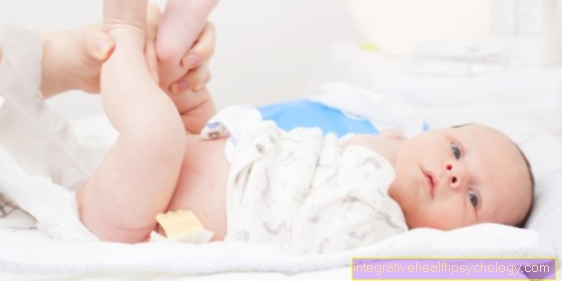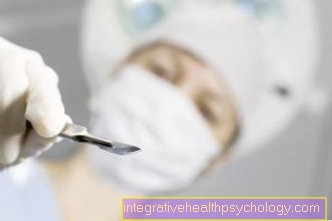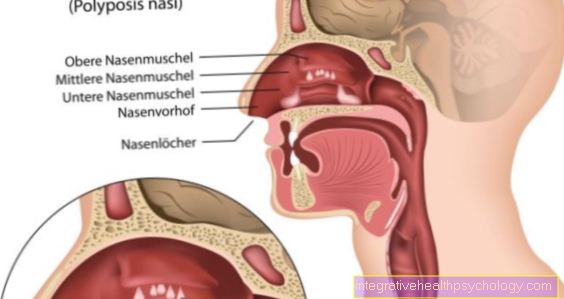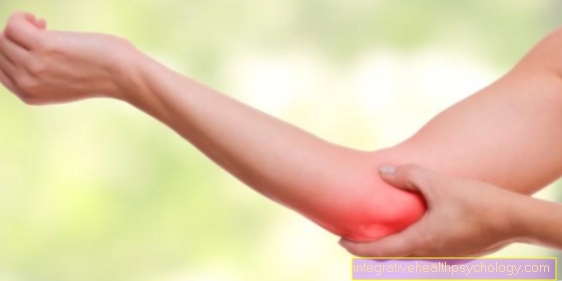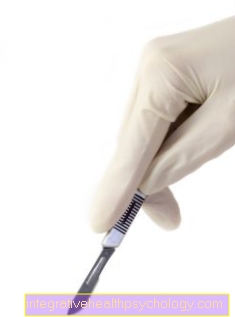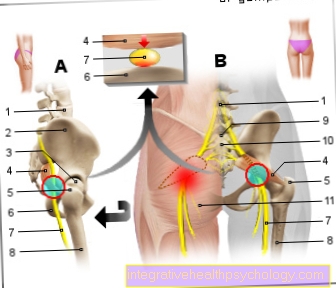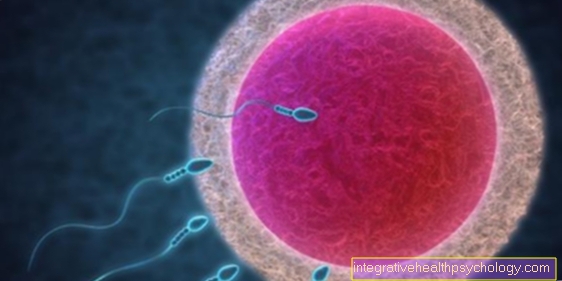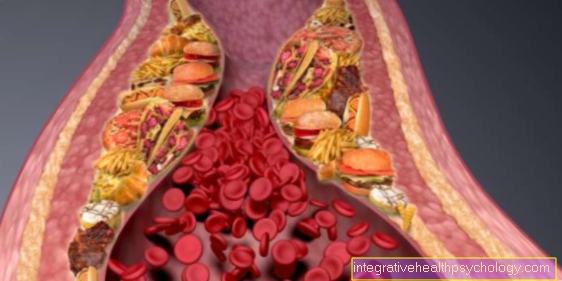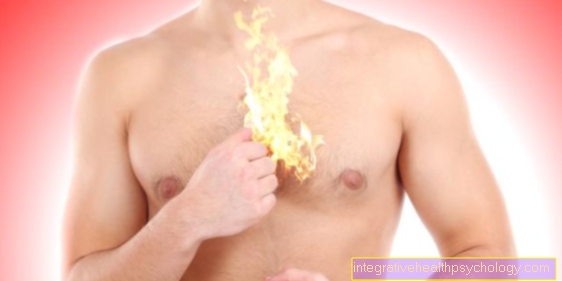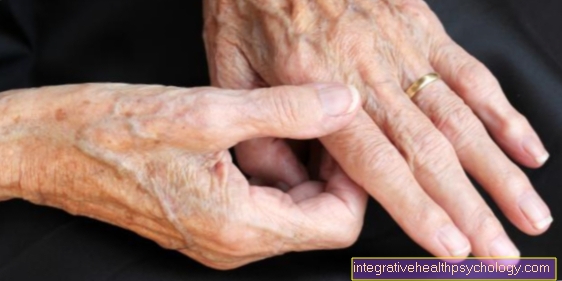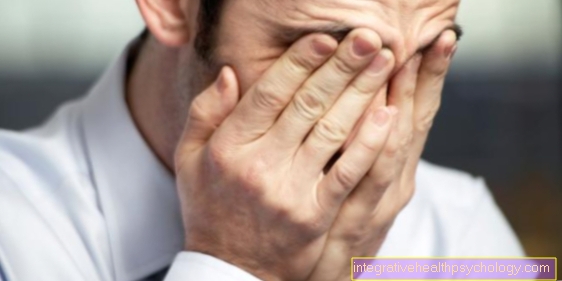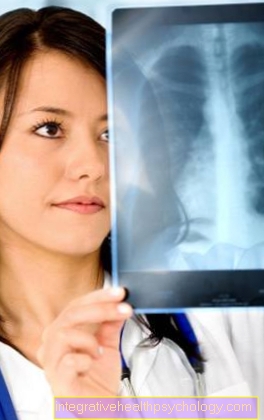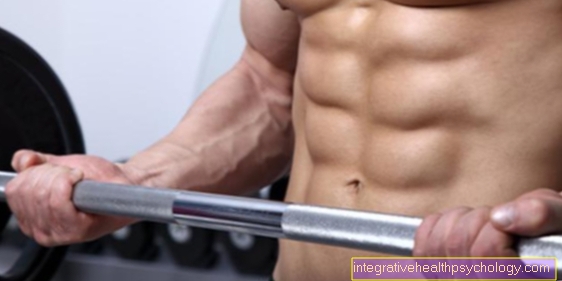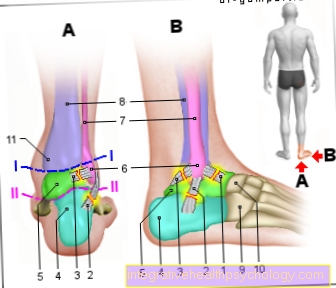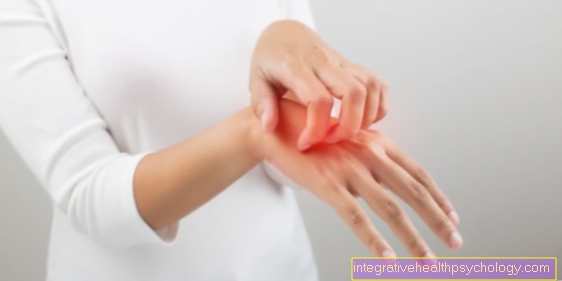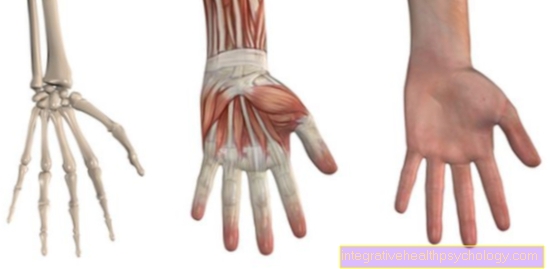Tietze Syndrome
Definition / introduction
The Tietze syndrome describes a change in the costal cartilage at the base of the sternum. It presents itself with pain and swelling of different strength and radiation. More precise knowledge about the origin of the Chondropathy (Cartilage damage) in the course of Tietze syndrome have not yet been found.
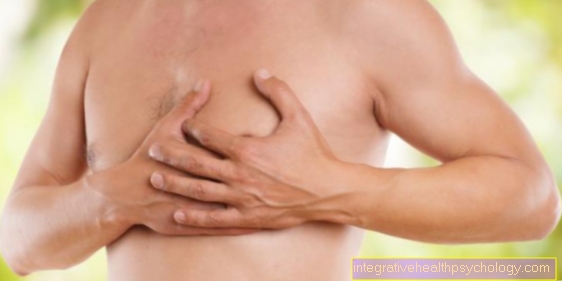
Symptoms
The symptoms that patients describe in the course of Tietze syndrome vary widely.
Further information can also be found at: Stitching in the right chest
Pain
The main symptom of Tietze syndrome is pain in the sternum. In some cases, the pain also radiates to the back, neck, shoulders or arms, although it can be provoked and exacerbated by coughing, sneezing or deep breaths in and out. These pains can sometimes cause an oppressive sensation in the chest, although it is not uncommon for frightening thoughts about heart problems to arise, which are ultimately the reason for going to the doctor. The pain is caused by an inflammatory process in the area of the sternum cartilage.
In most cases, the complaint is rib pain in and around the joints between the ribs and the sternum. This can be the case in peace. However, the pain often occurs when moving. The occurrence begins, for example, after a new or unfamiliar activity (somewhat heavy lifting). After that, the problem persists for days to weeks or even longer and restricts those affected from performing their everyday activities. Furthermore, in some cases, the affected joints become overheated, reddened and also palpable induration or swelling that is visible and palpable from the outside.
Ribs 1-3 are very often affected by the problem described above. The symptoms can also appear on the other ribs attached to the sternum (up to the 7th rib).
Due to the sometimes high position on the first ribs, the pain can radiate into higher body regions. Some patients complain of pain in the neck region and the pain radiating to the shoulders and arms. Accordingly, an adequate examination is indicated to rule out any other causes of the symptoms.
By adopting a gentle posture to avoid pain, pain can occur in other places as a result, e.g. Muscle cramps in the chest, shoulder and back area. When breathing in and out, the movements of the thorax (chest) can cause pain.
Read more on the subject at:
- Left costal arch pain
- Right costal arch pain
Appointment with ?

I would be happy to advise you!
Who am I?
My name is dr. Nicolas Gumpert. I am a specialist in orthopedics and the founder of .
Various television programs and print media report regularly about my work. On HR television you can see me every 6 weeks live on "Hallo Hessen".
But now enough is indicated ;-)
In order to be able to treat successfully in orthopedics, a thorough examination, diagnosis and a medical history are required.
In our very economic world in particular, there is too little time to thoroughly grasp the complex diseases of orthopedics and thus initiate targeted treatment.
I don't want to join the ranks of "quick knife pullers".
The aim of any treatment is treatment without surgery.
Which therapy achieves the best results in the long term can only be determined after looking at all of the information (Examination, X-ray, ultrasound, MRI, etc.) be assessed.
You will find me:
- Lumedis - orthopedic surgeons
Kaiserstrasse 14
60311 Frankfurt am Main
You can make an appointment here.
Unfortunately, it is currently only possible to make an appointment with private health insurers. I hope for your understanding!
For more information about myself, see Lumedis - Orthopedists.
Shortness of breath
During the breathing process there is a movement of the entire chest with joints and muscles. The simple breathing movement comes from the diaphragm (Diaphragm), which contracts through its contraction and creates a negative pressure that expands the lungs - this process takes place when you inhale. When you exhale, the diaphragm relaxes again and the air is forced out. In addition to the diaphragm, other muscles are involved in the breathing process - e.g. the internal and external intercostal muscles (Internal and external intercostal muscles). These muscles have their origins and attachments on the ribs. When breathing, the ribs are consequently pulled, which can lead to pain in the presence of Tietze syndrome. Pain often limits the ability to adequately perform the breathing movement - there is a risk that the patient will develop a feeling of shortness of breath due to the avoidance of pain.
This shortness of breath must be clarified and it must be ensured that no disease of the heart or lungs (pneumonia, metastases, COPD, edema, etc.) or psychological reasons are responsible for it.
Furthermore, the shortness of breath must be treated symptomatically. If it is an acute event following a wrong movement (i.e. newly occurring Tietze syndrome), you should use more analgesic (pain-relieving) therapy or with orthopedic options an improvement can be achieved. In the case of long-term shortness of breath, the same means can be used - but more attention should be paid to other reasons and causes.
Back pain
Tietze syndrome is actually defined as a painful disease in the area of the cartilaginous ribs that are connected to the sternum. The occurrence of back pain can therefore not be described as a symptom of Tietze syndrome. Rather, back pain can occur as a secondary, i.e. subsequent complaint, if the affected person takes relieving postures due to the severe pain in the sternum area. The relieving posture is usually equated with a poor posture, so that the symptoms of complaints are preferably shifted to the back but also to the shoulder area.
causes
The causes of Tietze Syndrome have not been conclusively clarified. However, the various symptoms are often described in connection with unfamiliar activities and stress. One reason could be the overuse of the respective rib attachments on the sternum, e.g. when engaging in a new activity at work or in leisure time (sport, unusual lifting movements, e.g. when carrying boxes).
Overuse of the cartilage at the base of the ribs can also result from improper stress on the joint. If, for example, one or more vertebral or rib joints are blocked (limited mobility of the respective joint), the resulting unphysiological (Non-normal) posture and exercise lead to the fact that some joint areas are stressed in a form and strength that they are not otherwise exposed to. This exposure, which deviates from the norm, can lead to inflammation and irritation of the corresponding costal cartilage.
One possible cause of Tietze syndrome is so-called micro-fractures in the ribs. These are small cracks in the ribs that have not caused any symptoms before, but in the long term cause irritation or inflammation due to the changed force on the costal cartilage. Another reason for this course can also be found in previous operations on thorax (Chest) in which the original position of the ribs or articular surfaces was not fully restored during the healing process.
Since no complete mechanism for the development of Tietze syndrome is known, it must be assumed that other causes exist. Accordingly, if the problem is unclear, it should be looked for further possible causes in the person concerned.
also read: Sternum pain
diagnosis
The diagnosis takes place after questioning the person concerned. Depending on the type and severity of the symptoms, diseases of the heart (angina pectoris) and other organs must be excluded.
Many patients are very concerned that the symptoms are from cancer or the heart. An experienced doctor can, however, rule out another disease through appropriate diagnostics and laboratory tests.
The rib and sternum joints that are affected by Tietze syndrome are at Palpation (Scanning) described by the doctor as painful or pressure-sensitive. The severity of the severity of the pain can vary greatly from patient to patient.
roentgen
The representation in roentgen is in the majority of cases not leading, as with Tietze Syndrome mostly no injuries or significantly different positions of the bony structures lead to the development of the symptoms. To the Exclusion of breaks the involved bony structures, such as of the respective rib, however, taking an X-ray can be helpful.
MRI of the sternum
An MRI of the sternum can be helpful for further clarification. In contrast to X-rays, soft tissue structures can be displayed in MRI. Because of this, it is possible to see swelling and fluid build-up (caused by inflammation). If Tietze syndrome is present, the affected joints or the cartilage are swollen on the MRI.
Therapy / treatment / what helps?
Due to the inflammatory process, many patients experience pain when moving, exercising or sometimes breathing.
By the use of Analgesics (Painkiller) and Anti-inflammatory drugs (Anti-inflammatory drugs) can reduce the pain and also the inflammatory process. Here ibuprofen and diclofenac (Cox inhibitors) are particularly suitable as agents of choice. However, these should not be taken in high doses for long periods of time as they can lead to dangerous bleeding in the stomach. In the case of acute pain, slight Muscle relaxants (Medicines to relax muscles) be used - this becomes the tone (the tension) of the muscles is reduced and with it the tension on the areas affected by Tietze syndrome.
Furthermore, the respective joint can be treated locally with an anesthetic for acute pain relief. A local anesthetic (medication for local anesthesia) is injected into the affected costal cartilage.
Osteopathy / manual therapy
In the application of the manual therapy / osteopathy there is a possibility of the pain through Correcting deformities of the ribs, vertebrae and the sternum (Sternum) to fix each other.
The idea behind this is that blockages in the joints between the ribs and vertebrae result in an unnatural posture and movement of the upper body. The targeted removal of these blockages using various manual therapy techniques Improper loading removed or reduced and the pain should decrease or ideally go away. Since the incorrect posture has existed for longer periods of time in many cases, it often takes time for the inflammation to subside and the body to adjust to the original posture. The Strengthening the muscles in the course of physical therapy or targeted training are helpful for long-term stabilization and the prevention of further cases.
Which exercises can help with Tietze syndrome?
As a rule, special therapy is not necessary for Tietze syndrome, as the disease and with it the pain will go away on their own.
In some cases, the doctor may prescribe anti-inflammatory pain relievers to accompany them, as well as various simple exercises to do at home. Consciously sitting down for 5 minutes and concentrating on breathing and breathing movements is one way of doing something to improve yourself at home. Since the breathing movement can often trigger pain in the chest / sternum, conscious "counterbreathing" against the pain is beneficial in order to counteract the often automatic shallower breathing.
Posture correction while sitting can also be consciously carried out several times a day: straighten your back, pull your head a little towards the ceiling, bring your chin slightly towards your chest, lower your back a little into the hollow of your back, bring your shoulder blades together so that the chest moves forward.
Finally, you can also do a stretching exercise for the middle back and chest: in the quadruped position, first go into the hollow back (put your head back on the neck) and then hunch your back by bringing your chin up to your chest. Alternate both positions several times in a row.
surgery
The operation in the presence of Tietze syndrome usually does not represent a therapeutic component of the possible treatment approaches. The reason for this is, on the one hand, that it has been proven that the symptoms often resolve on their own and that patients would be "over-treated" with an operation. Even the chronic form is not treated surgically, since in many cases there is no clear reason and there is therefore no therapeutic point of attack for operative treatment. For another, there is far more effective and less invasive therapy options (E.g. medication, physiotherapy and acupuncture) that usually do not require surgery. Ultimately, generally speaking, the lack of need for an operation, with insufficient symptoms and the lack of clarity of the origin, can be seen as the reason for deciding against an operation for Tietze syndrome.
Can Physiotherapy Help?
Going to the physiotherapist is rarely recommended by the attending physician in the case of Tietze syndrome, as the symptoms usually resolve on their own after a while. Physiotherapy can only make sense in this clinical picture in that it is used to counteract a relieving posture in the trunk that is triggered by the pain.A relieving posture often leads to the core muscles becoming cramped and not allowing movement freely, so that additional pain can arise from muscle hardening. Loosening, relaxing massages of the back muscles, trigger point treatments, manual therapy, proprioceptive neuromuscular facilitation (PNF) and craniosacral therapy are used here. The above-mentioned exercises for at home can also be taught by the physiotherapist.
homeopathy
For the homeopathic treatment of Tietze syndrome, various preparations can be used injection (for spraying) can be used. Mainly the two preparations Zeel® and Traumeel® are used. You will be injected into the affected joint over several weeks. Its actual area of application, however, is primarily in the treatment of arthritis in joints.
Forecast / duration
The occurrence of Tietze syndrome is in many cases a very short process in the course of a faulty movement.
Just as it can happen very quickly, the problem can go away again. It can be a brief pain that lasts a few seconds to minutes. In these cases the joint has slipped back into its original position by itself and no chronic pain problem arises. In other cases the problem persists for days to months. In rare cases, Tietze syndrome persists.
The healing itself almost always takes place without medical intervention. However, many patients are limited in everyday life by their symptoms, which is why therapy with painkillers can be used.
How long a Tietze syndrome lasts depends, as with many diseases, on many sometimes unpredictable factors.
Can Tietze Syndrome become chronic?
Tietze syndrome is a disease that usually disappears on its own, which means that special treatment is not necessary. The pain that occurs is often treated with the addition of anti-inflammatory painkillers such as ibuprofen or diclofenac; in severe cases, they can be combined with cortisone preparations. A chronic course is very rare, so the prognosis is good and damage usually does not remain.
Can Tietze Syndrome be a sign of Bechterew's disease?
Tietze syndrome itself is not a syndrome of ankylosing spondylitis; nevertheless, ankylosing spondylitis should be considered as a differential diagnosis for pain in the sternum. In addition to the classic symptoms of this disease, pain over the breastbone with limited burst basket expandability during breathing can also be noticed, although the cause is unclear. Since ankylosing spondylitis is a chronic rheumatic disease, preferably of the spine and the joint between the colon and sacrum (Sacroiliac joint) acts of unknown cause, the involvement of other joints, e.g. the rib-sternum-joints (Sternocostal joints) possible.
Find out more about Bechterew's disease on our website ankylosing spondylitis
Tietze Syndrome in Pregnancy
The fact of pregnancy is a burden for the body in many ways. Pain in the ribs, which, depending on the location, can lead to the development of Tietze syndrome, are therefore not uncommon symptoms during pregnancy. The enormous increase in abdominal girth favors the enormous stretching of the abdominal muscles. Since some of the abdominal muscles start in the rib area, the stress can be transferred to the ribs and sternum and cause symptoms of Tietze syndrome. The fact that the costal arch is subjected to pressure from the abdomen explains the origin of the symptoms, as the stretch is transferred to the articulated connection between the ribs and the sternum. The intensity of the symptoms can vary, but in most cases the symptoms subside after the birth.
The situation is different if Tietze syndrome existed before pregnancy. Then the symptoms can of course worsen and possibly require treatment, so that conservative and medicinal therapeutic agents must be used.
Read more on the subject at: Costal arch pain during pregnancy

